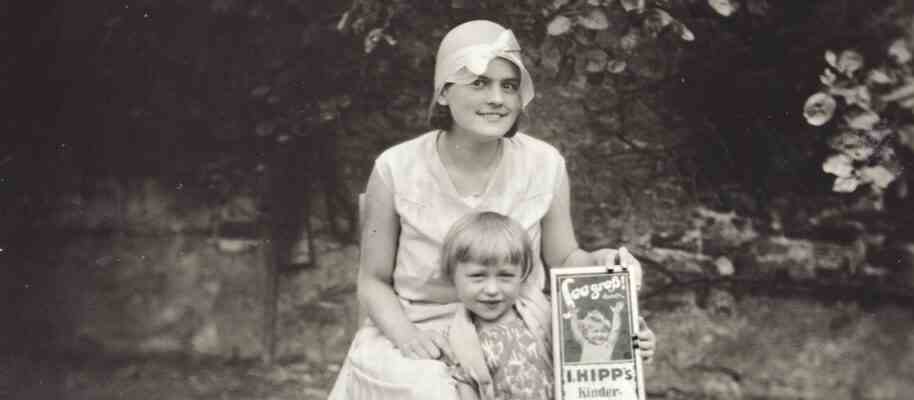As a rule, treasures are only discovered by chance. The same happened to the Pfaffenhofen businessman Hans Hipp. Five years ago, after handing over his parents’ house, which has a 400-year tradition as a pastry shop, café and waxworks, to his son Dominik, he finally found time to take a closer look at the crates and boxes stored in the attic. In addition to the old tools from the gingerbread factory and the wax factory, he found notes, letters, business records and diaries there. As it quickly turned out, this was an almost unbelievable legacy from Hipp’s grandfather Joseph Hipp. The papers cover the entire period from the grandparents taking over the business on August 11, 1897 to the end of Kinder-Zwieback production in 1932.
There is hardly a company whose history has been handed down in such detail. For example, even at a christening ceremony, every gram of cold cuts consumed was recorded. It was just something special in poor times. In order to be able to read and evaluate the writings, which go down to the smallest detail, Hans Hipp learned the Sütterlin handwriting in the crash course. “The subject grabbed me immediately,” he says.
In a time without telephone and e-mail, business communication took place almost exclusively via handwritten letters. In conjunction with the household and diaries, Joseph Hipp’s many correspondence by letter provide deep insights into the private life of the family in difficult times.
The extraordinary find motivated Hans Hipp to write down the history of his family and the beginnings of the company that made the name Hipp a household name in the baby and infant food sector in a book that is now entitled “Das Lebzelterhaus and the founding history of the Hip Babykost” has been published. “The documents tell us in detail about the production process in a craft business that is still governed by the guild system,” says Hipp.
Marie and Joseph Hipp with their five children, around 1907. Marie shows her son Georg, who later founded Hipp Babykost, where the bird comes out of the camera.
(Photo: Hans Hipp family archive)
Among other things, the notes reveal why Joseph Hipp really wanted to produce a universal food for infants and small children. He himself had experienced a high rate of infant mortality in his family, a fate that he wanted to spare his own family. Joseph Hipp and his wife were parents of eight children. The books of miracles in the surrounding pilgrimage churches are full of shocking reports about children dying. The rusk flour developed 125 years ago was intended to ensure children’s survival in their first years of life. As a business idea, however, it was not suitable at the beginning. On the contrary, his grandfather realized that he could help many people in this way, says Hans Hipp. “That was his social drive.”
Display pack of children’s rusks from the 1930s.
(Photo: Hans Hipp family archive)
The documents document severe setbacks, but this did not weaken belief in their own product. Above all Georg, the son of Joseph Hipp, showed staying power. In 1932 he ventured into self-employment and founded his own company in Pfaffenhofen, which now produced baby food on an industrial scale. He was not short of innovative ideas. With a minimum purchase, for example, there were free packs, in return the mothers had to share their experiences with the tasting. 30,000 such letters to mothers have survived, Hipp has read 8,000 and learned a lot about the hardships of life at that time. For example, that some mothers could only afford rusk flour for one child, the rest didn’t get chubby cheeks.
Handmade advertising poster for confectionery, café and J.Hipp’s Kinder-Zwieback-Flour, around 1931.
(Photo: Hans Hipp family archive)
While one branch of the family has been producing baby food for 90 years, the branch to which Hans Hipp belongs still runs a pastry shop with a café and a wax workshop on the main square in Pfaffenhofen. Hans Hipp also fundamentally documented this 400-year tradition based on the old crafts of the gingerbread maker and the wax maker. There was a natural connection between the crafts: the necessary raw materials – honey and wax – were supplied by the bee. “According to the guild regulations of 1587, only Lebzelter were allowed to process honey and wax,” explains Hipp.
Dealing with this topic teaches a lot about life. Just a small example: The initiation of a love affair today is done in a very unromantic way via Whatsapp or Tiktok. It used to be that a young man in love gave his crush a gingerbread. If the Gspusi was also on fire, then it bit off a piece of the gingerbread and showed the admirer that it liked to eat it, as Hipp says with a laugh.
Hans Hipp, as Lebzelter and wax maker one of the last of his guild. Also author of books on wax and votive customs and the eventful history of the Hipp family.
(Photo: Hans scratches)
Hans Hipp, 73, knows the worries and fears of previous generations inside out. Because he has also evaluated more than 10,000 miracle book entries from Niederscheyern. During this study, he not only got to know the needs of the population, but also their hopes in the face of the helplessness to which they were exposed by plagues and catastrophes. “There was no social safety net,” says Hipp. Poorer classes could not even afford treatment at the barber. So only the refuge remained to the heavenly powers, to saints and patron saints. In his book “Wax between Heaven and Earth”, Hipp illuminates the almost forgotten topic of wax and votive offerings in a hitherto unknown depth and density.
He will not write any more books, says Hipp. He still has one big goal: He wants to redesign the gingerbread and wax museum that existed in his café until it was renovated. The first exhibition will be dedicated to the topic of candles.

